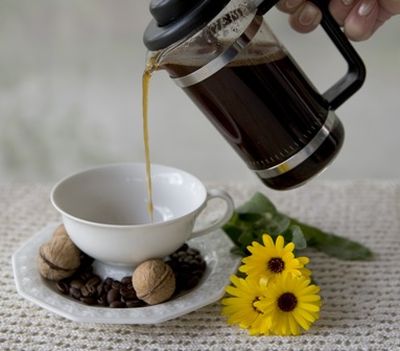Coffee with a conscience

A good, strong brew with a dash of whole cream straight from Chocolate, my milk cow. That’s how I take my coffee. Whether it’s sunup or during a late-night brainstorm, I love a hot cup of joe. It offers comfort and eye-opening energy all in one — what more could you ask for? Researchers are even starting to confirm that moderate coffee consumption has health benefits, something coffee lovers have suspected for eons. And there’s an added boost these days knowing that conscientious coffee choices help nurture social and ecological conditions around the globe.
As an organic farmer, I feel a very personal connection to the people who are striving to grow coffee beans a world away. It’s the same no matter where you are: if you try to wring dollars out of the ground, you end up wringing it dry. But if you coax the Earth, listen to it and work with it in synchrony, you reap richness that extends beyond your pocketbook. It is that richness that we taste when we savor a cup of ecologically grown coffee. And it’s worth every penny!
“Sustainable coffee is produced on a farm with high biological diversity and low chemical inputs. It conserves resources, protects the environment, produces efficiently, competes commercially and enhances the quality of life for farmers and society as a whole,” says the Smithsonian Migratory Bird Center. But how can we as coffee consumers make sure that our dollars are going toward good growing practices? The key to finding coffee with a conscience is the lingo on the label, which can confuse even the greenest-minded javaholic. With a bit of filtering, though, it’s easy find the best brew for you and the planet.
Here are the best indicators:
“Shade-Grown” or “Bird-Friendly”
Means that the coffee beans have been grown on plantations with a forest canopy rather than on clear-cut land. Under canopy cover is where coffee naturally grows, so shade-grown plants need less chemical “assistance” to thrive, and the forested habitat supports lots more wildlife than a sun-baked landscape of coffee plants alone. Shade-grown and bird-friendly labels require the strictest environmental standards of any certification system, stipulating certified organic production as well. So these labels are your best bet when it comes to finding truly sustainable coffee.
“Organic”
Organic certification tells you that chemical pesticides and fertilizers have been reduced or eliminated during the growing process. Look for “100% organic” on labels to make sure you’re not paying premium prices for just a pinch of pesticide-free product.
“Fair Trade”
Fair Trade certification ensures that companies pay coffee farmers fair prices and that working conditions are also fair. This keeps smaller farmers in business and encourages more ecologically conscious growing practices.
There are other certifications, including Utz Certified and Rainforest Alliance, that offer some assurance of quality, but they don’t stand up to the industry’s most stringent environmental criteria.
When you consider how many millions of cups of coffee Americans drink each day, it’s clear that we have a tremendous impact on the people and places that grow it. How will you fill your cup?
“Direct Trade”
Direct Trade certification eliminates the middleman. Coffee beans are purchased directly from the farmer, meaning the farmer is paid more than a Fair Trade price.
PULL-OUT BOX: TAKE THE PLUNGE
To get an even greener cup of coffee, ditch the electric drip machine and take the plunge — the plunge pot, that is. I’m talking coffee unplugged. A plunge pot (also known as a French press) is a cylindrical carafe made of glass, stainless steel, or heavy plastic. What makes it unique is that its lid is equipped with a wire or nylon mesh “plunger” and it has no cord to tie it down.
The plunge pot’s energy-efficient brewing process is really simple — every bit as easy as an electric model. All you do is pour coarsely ground coffee and hot water together in the pot, leave it to brew for a few minutes, and then press the plunger down to filter the grounds and capture them at the bottom. Voila!
Since the coffee grounds get to steep directly in the water, plunge pot coffee is full of rich, flavorful oils that are skimmed away by paper filters. And how nice it is not to have to buy an ongoing supply of filters that leach who-knows-what into your daily brew and end up in landfills by the bazillions.
If you still need convincing, think portability. A plunge pot is good to go. Wherever you have access to hot water, you can brew coffee — kitchen, office, hotel room, campfire. There’s even a travel plunge mug, tough enough to stow in a backpack that functions as both a brew pot and drinking cup. Home and travel presses costing between $30-70 can be ordered online from either www.domacoffee.com or www.bodumusa.com